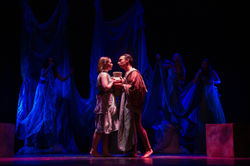
DYSKOLOS
by Menander
 |  |  |  |  |  |
|---|---|---|---|---|---|
 |  |  |  |  |  |
 |  |
«Sbagliavo, magari, ma solo nel pensare che, tra tutta questa gente, io ero il solo bastante a sé»
Photos by Camilla Canalini and Giulia Ceravolo Intra
While his chaotic family is in File preparing a banquet at the temple of Pan, Sostrato, a young and wealthy citizen, falls madly in love with a delightful country girl. However, the girl is the daughter of Cnemone, a gruff and antisocial old man who keeps himself away from other people and does not allow anyone to cross the threshold of his house. Will Sostrato, after many adventures, succeed in winning the girl's heart and, above all, in convincing her misanthropic old father?
The caricature of the misanthropic character in this comedy presents an archetype that was destined to be very popular in later periods: think of Molière's The Misanthrope, Shakespeare's Timon of Athens, Goldoni's Sior Todero brontolon, Schiller's incomplete The Misanthrope and Eugene Labiche's The Misanthrope. In particular, Menander's comedy, together with the humour of the caricature of this human flaw, offers important food for thought on the themes of friendship, marriage as an authentic bond of love, the generational relationship between father and son, and the possibility of overcoming the distances and differences between social classes.
Dramaturgical direction: Elisabetta Matelli
Stage direction: Christian Poggioni
Restaging: Federica Gurrieri




